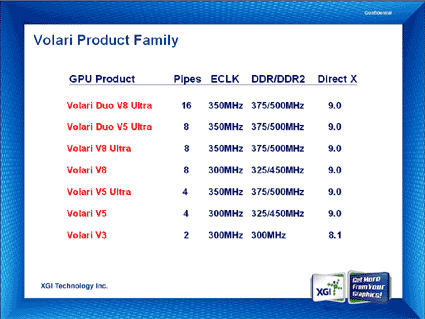A New Graphics Kid on the Block: XGI Volari
Product Overview
XGI has named its product line "Volari", which stems from the Latin word Volatus. If that word looks familiar, that's because the English word velocity finds its roots there as well. XGI divides its product line into three categories. First, there are the enthusiast and mainstream segments, each of which will feature three cards featuring DirectX 9 chips. Additionally, there is the low-cost segment with one DirectX 8.1 chip.

The Volari V8 is the flagship model of the lineup. This 256bit chip is manufactured on a 130-nanometer process and offers full DirectX 9 support. The design sports eight-pixel rendering pipelines with a total of four pixel shader 2.0 units as well as two vertex shader 2.0 units. All in all, the chip has about 80 million transistors, which is roughly equivalent with NVIDIA's NV 36 chips. It supports both GDDR and GDDR-2 memory modules (max. 256 MB), accessed through a memory interface XGI quaintly calls BroadBahn. This interface subdivides the memory into four channels of 128bit each, giving it an internal bit-width of 512bit. Since the modules are only addressed using a 32bit bus, the actual resulting memory bus bandwidth is 128bit.

Volari V8 single chip solutions:
- Volari V8 Ultra: 8 pixel pipes, Core frequency: 350 MHz, memory frequency: 375 MHz with DDR, 500 MHz with DDR2
- Volari V8: 8 pixel pipes, core frequency: 300 MHz, memory frequency: 325 MHz with DDR, 450 MHz with DDR2
The image output is handled by an internal 400 MHz RAMDAC. A second display can also be used, thanks to the external video bridge chip SIS301 MV, which is also responsible for the TV output. XGI has developed its own pixel-based interpolation method for video playback. This is handled by the Cypher Video Processor built into the graphics chip. XGI claims that its method greatly improves the image quality of interlaced film material compared to the popular bob and weave methods.
Stay on the Cutting Edge
Join the experts who read Tom's Hardware for the inside track on enthusiast PC tech news — and have for over 25 years. We'll send breaking news and in-depth reviews of CPUs, GPUs, AI, maker hardware and more straight to your inbox.
Current page: Product Overview
Prev Page First Contact : XGI Volari Next Page Product Overview, ContinuedMost Popular

